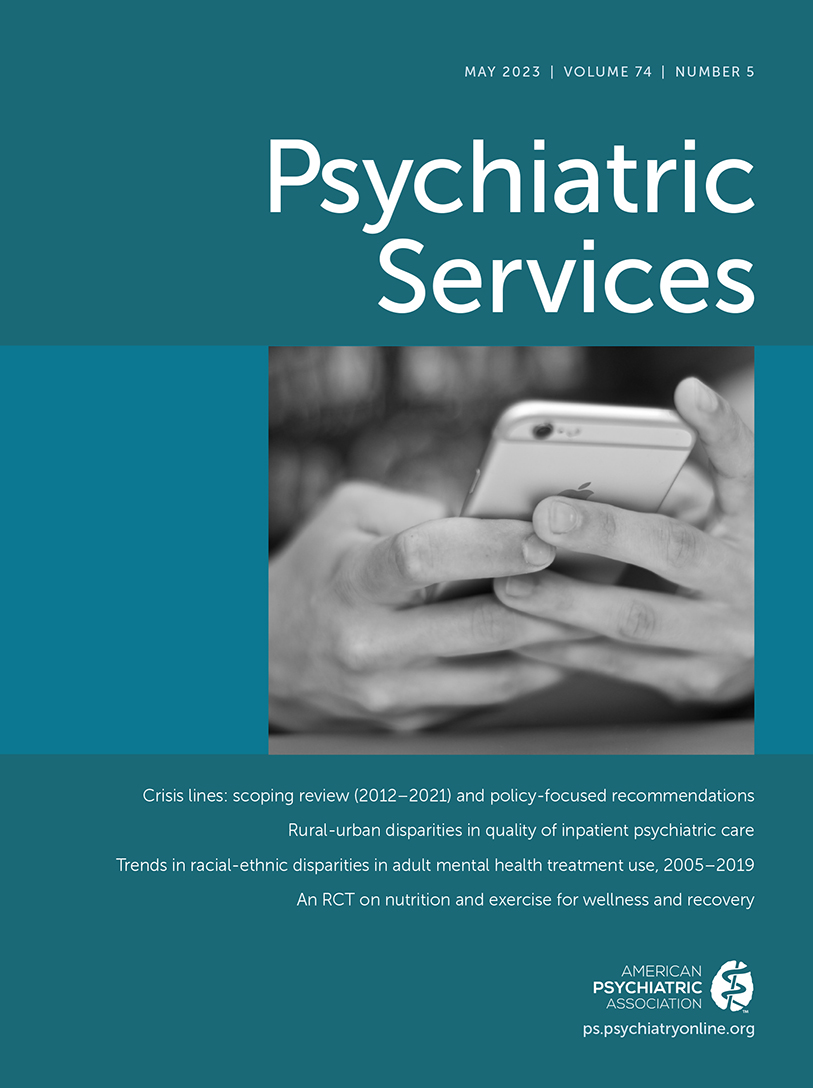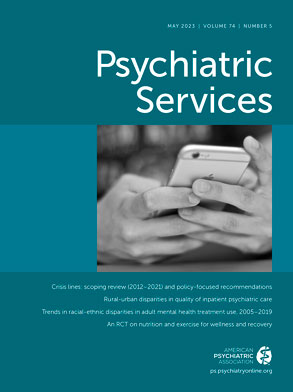This section describes the use of CROMs versus PROMs and PREMs or FROMs and FREMs for each domain and the number of studies using each measure (see Assessment Domains in Early Intervention Services in the online supplement). Overall, 60% (N=103 of 172) of all measures in all domains were CROMs, 30% (N=52) were PROMs/PREMs, and 10% (N=17) were FROMs/FREMs.
Program assessment.
Program assessments included three domains and involved 19 measures. Program fidelity was assessed by using seven measures in eight studies (references S16, S24, S25, S39, S42, S46, S48, S95), typically by using data from multiple sources, such as interviews, observation, chart reviews, and documents. Patient engagement was assessed by using a CROM, the Service Engagement Scale (SES), in two studies (S53, S95), and two studies used PREMs: the Working Alliance Inventory (WAI) (S26) and the Scale to Assess Therapeutic Relationships–Patient (STAR-P), Public and Patient Engagement Evaluation Tool (PPEET), and the Patient-Centered Outcomes Research Institute Engagement Activity Inventory (PECI) (S25). Satisfaction with services was assessed during follow-up at multiple time points by using five measures in 12 studies (S6, S25, S41, S45, S46, S53, S84, S86, S87, S99, S107, S110). The Client Satisfaction Questionnaire (CSQ), a PREM, and a modified family version were most frequently cited (S41, S45, S46, S53, S84, S86, S87, S107, S110).
Program fidelity was assessed by using CROMs exclusively, whereas studies used CROMs and PREMs to assess patient engagement with services and PREMs or FREMs to assess satisfaction. Remarkably, no studies, including program or service model evaluations, evaluated clinician attitudes, knowledge, skills, or related competencies.
Patient assessment.
Most measures (N=136 of 172, 79%) were used to assess patient presentation at treatment or study entry and outcomes during follow-up. Characteristics assessed included premorbid functioning, duration of untreated psychosis (DUP), diagnosis, symptomatology, comorbidity, risk, functioning, and quality of life, among others (see Assessment Domains in Early Intervention Services in the online supplement).
Thirty studies estimated DUP, with seven measures administered by clinicians or external observers; 23 of these studies used the interview-based (Early Recognition) Inventory for the Retrospective Assessment of the Onset of Schizophrenia (ERIRAOS and IRAOS), or Circumstances of Onset or Relapse Schedule (CORS) (references S19, S26–28, S30–32, S35, S37–39, S43, S45, S46, S50, S59–61, S64, S66, S67, S71, S73). DUP was usually assessed in studies reporting outcomes (N=21 of 30, 70%) (see Characteristics of Studies Included in the online supplement).
In 72 studies, diagnoses or diagnostic categories were established by using 15 measures, with the Structured Clinical Interview for DSM Disorders (SCID) used in 51 (71%) of these studies. The Schedule for Clinical Assessment in Neuropsychiatry (SCAN) was used in 10 studies (S39, S43–46, S49, S50, S99, S100, S102), and multiple other instruments were used in 11 studies (S15, S19, S37, S52, S69, S71, S72, S93, S94, S99, S112). Two studies used four patient-report measures (S3, S72), one study a family-reported measure (S52), and the others used CROMs, including interviews and checklists. Studies often established diagnoses at baseline and reassessed them after 1 year.
Psychosis symptomatology was the most frequently assessed domain (N=95 of 115 studies, 83%). Symptoms were assessed at single time points and at follow-up to determine change in clinical status by using 12 measures. Among studies assessing psychosis symptomatology, the Positive and Negative Symptom Scale (PANSS) was used most frequently (N=57 studies, 60%), followed by the Scale for the Assessment of Negative Symptoms (SANS, N=30, 32%), the Scale for the Assessment of Positive Symptoms (SAPS, N=25, 26%), and the Brief Psychiatric Rating Scale (BPRS, N=21, 22%). Symptom measures for psychosis were commonly used in combination (see Characteristics of Studies Included in the online supplement), and only three were PROMs: the Brief Symptom Inventory (BSI), measuring paranoia, positive symptoms, anxiety, and depression (S2, S10); the Frankfurt-Pamplona Subjective Experiences Scale (FPSES) on subjective experiences (S72); and the Community Assessment of Psychic Experiences–Positive 15 (CAPE-P15) for psychotic-like experiences (S113).
Comorbid symptomatology was also assessed at multiple time points during treatment. Depression was assessed in 36 studies with six measures, including three PROMs and three CROMs. The Calgary Depression Scale, a CROM, was most frequently used (N=25 studies, 69%), likely because of its specific focus on depression in schizophrenia (
59) and its ability to distinguish depression from negative symptoms (
60,
61). Five studies (S1, S8, S72, S101, S104) used the Beck Depression Inventory, a PROM. Anxiety and mania were each measured in five studies by using two PROMs (S112, S113) and one CROM (S7, S30, S32) for anxiety as well as one CROM for mania (S2, S51, S64, S88, S95). Substance use and related problems were assessed in 28 studies by using 17 measures—12 CROMs and five PROMs (see Assessment Domains in Early Intervention Services in the
online supplement). Only seven of these studies used the following PROMs: Alcohol Use Disorder Identification Test (AUDIT) (S22, S33, S85, S89), Adolescent Drug Abuse Diagnosis Instrument (ADAD) (S6), Adolescent Alcohol and Drug Involvement Scale (AADIS) (S25), Drug Abuse Screening Test (DAST) (S22, S33), and Compulsive Internet Use Scale (CIUS) (S53). Suicidality and other risks (e.g., violence and dangerousness) were assessed in six studies using seven measures, two of which—the Adolescent Suicide Questionnaire–Revised (ASQ-R) (S6) and Inventory of Suicide Orientation 3D–Adolescent version (ISO-3D) (S2)—were PROMs.
“Functioning” was a broad term used by many researchers (see Characteristics of Studies Included in the online supplement) that included overall functioning (both symptomatology and general functioning), social and occupational functioning, and premorbid functioning. Sixty-eight studies used 14 measures of overall functioning, including eight CROMs, four PROMs, and two FROMs (see Assessment Domains in Early Intervention Services in the online supplement). The Global Assessment of Functioning (GAF) was used in 52 (76%) of these studies, whereas 22 reported using more than one measure of functioning, including PROMs such as the 12–Item Short-Form Health Survey (SF-12) for health status (S107, S110), the Mental Health Inventory (S3), the Warwick-Edinburgh Scale measuring well-being (S64), and the World Health Organization Disability Assessment Schedule (WHO-DAS) 2.0 (S25). FROMs used to assess patient functioning included the WHO-DAS 2.0 and Life Skills Profile (LSP-20) (S25).
Social and occupational functioning was assessed in 34 studies using 10 measures, including eight CROMs. One-fourth of studies under this domain utilized more than one measure. The Social and Occupational Functioning Assessment Scale (SOFAS) (S2, S3, S5, S12, S22, S33, S34, S52, S54, S55, S57–62, S64, S66, S93, S94) or SOFAS Personal and Social Performance Scale (SOFAS-PSP) (S7, S26) were used in 22 studies, the RFS in nine (S55, S58–62, S64, S107, S115), and the Social Functioning Scale (SFS) in two (S111, S114). Three studies used the SFS as a PROM (S10, S106, S112), and one (S95) asked patients to report on their use of time on a list of activities over the previous month. Nearly all studies assessing premorbid functioning (N=25 of 26) used the Premorbid Adjustment Scale, a CROM.
In 36 publications, quality of life was assessed with 12 measures, most commonly Heinrichs’ Quality of Life Scale, a CROM (S2, S5, S7, S14, S17, S18, S19, S25, S33, S98, S109, S114). Six instruments measuring quality of life were PROMs: the World Health Organization Quality of Life Brief or 26 (WHO-QOL-BREF/26) (S5, S7, S51, S72, S75, S85), Wisconsin Quality of Life (WQOL) (S26, S29), Subjective Satisfaction With Life Scale (SSWL) (S89), EuroQOL–5 Dimension (EQ-5D) (S53, S95), Quality of Life Enjoyment and Satisfaction Questionnaire (Q-LES-Q-18) (S53), and SF-12, a general health measure (S62, S64). Quality of life was assessed at multiple time points during follow-up, frequently in conjunction with symptom assessments (N=31 of 36 studies). Recovery was assessed with four PROMs (S25, S64, S107, S110).
Additional domains assessed were service use and cost (S23, S25, S68, S75, S95, S101, S102, S106, S109, S111, S114); life events and trauma (S2, S107, S110); personality, self-esteem, coping, and expectations (S2, S51, S71, S72); insight (S36, S51, S88, S95, S99); needs and strengths (S101, S108, S112), and family factors (S2). Of 21 measures used to assess these domains, 12 were CROMs (one was both a CROM and PROM) (see Assessment Domains in Early Intervention Services in the online supplement). Ten studies (S2, S3, S5, S9, S12, S32, S34, S35, S39, S97) used multidimensional measures, such as illness and symptom history, by using three CROMs and one PROM.
In summary, patient presentations, symptomatology, functioning, and recovery were overwhelmingly measured with CROMs (N=88 of 136, 65%). Very few measures were reported by patients (N=45, 33%), and few studies used PROMs to measure psychotic and comorbid symptoms (S1, S2, S6, S8, S10, S25, S72, S101, S104, S112, S113) (see Assessment Domains in Early Intervention Services in the online supplement). Recovery and quality of life were exceptions, because an equal or higher number of PROMs, compared with CROMs, were used to evaluate these domains.


